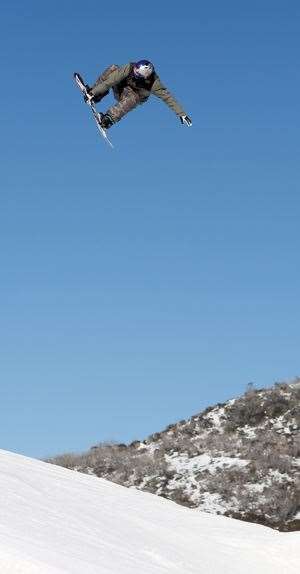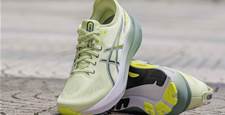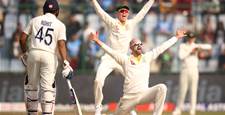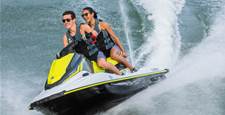Watch out for Scptt James performing triple-corks in the men’s halfpipe and slopestyle events at the Sochi Games in February 2014.
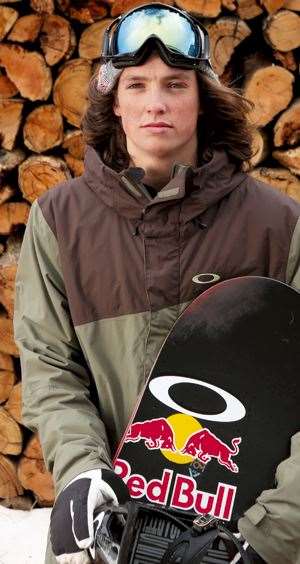 It seems like only yesterday that us Aussies looked at the Winter Olympics as a kind of parallel universe that told us how people who live in really cold places do sport. A Channel-Nine-cardigan-wearing Ken Sutcliffe feeding Down Under viewers Kirstie Marshall and Zali Steggall progress reports from a “mountain hut” TV studio in Lillehammer in 1994 was as close as we got.
It seems like only yesterday that us Aussies looked at the Winter Olympics as a kind of parallel universe that told us how people who live in really cold places do sport. A Channel-Nine-cardigan-wearing Ken Sutcliffe feeding Down Under viewers Kirstie Marshall and Zali Steggall progress reports from a “mountain hut” TV studio in Lillehammer in 1994 was as close as we got.
Speaking of ’94, that was the year Australian snowboarding wunderkind Scotty James entered the world. Only three Winter Olympics had passed between this birth and his debut at the Games as an excited, bright-eyed 15-year-old in 2010. The high-flying Victorian trickster was the youngest male athlete of all competing nations at those Olympics in Vancouver, and Australia’s youngest male Olympian in 50 years. Feeling old, dear reader?
Interestingly, James broke his wrist in the lead-up to the competition proper on Canada’s Cypress Mountain halfpipe, but absolutely nothing was going to keep this freakishly skillful teenager from performing on the world’s biggest stage. He finished well out of the placings, but has since been crowned junior world tour champion and US and European Opens champ.
Watch out for him performing triple-corks (and all sorts of other aerial tricks which hurt your back just watching) in the men’s halfpipe and slopestyle events at the upcoming Sochi Games in February. His is a natural talent finely tuned with a hell of a lot of dedication – and years of bouncing on a trampoline. Here, Scotty takes us through his plan of attack for a podium finish in Russia.
CHILD’S PLAY
“Before the 2010 Games, I had a lot of people telling me what the Olympics was all about – then I got there and found it was totally different. It’s going to be amazing this time around as well, but at 15, and having all my family there, it just didn’t seem real. I’d have to pinch myself walking back from the eating place by myself, after I’d eaten some McDonald’s. I’d be thinking, ‘How the heck did I end up here?’
“I think a lot of people were shocked that I was there, considering how young I was. Even I was shocked. At the Olympics though, the snowboarders have a lot of respect for each other; I was treated the same as someone who was 23 or 27.”
BROKEN WING
“I actually competed at the 2010 Olympics with a fractured wrist. I remember the pipe wasn’t too inviting in the lead-up practice sessions; there was hardly any snow falling in Canada at the time. The course staff had to drop in snow collected from other mountains. In a training session, I made a little error and fell and broke my wrist; I knew it was broken straight away. I was raced down to the village for an X-ray.
“There was nothing that was going to stop me from competing. I’d worked so hard to get to where I was. No one was going to tell me that I couldn’t drop into the halfpipe. I just went out there and had fun, like I’d planned to, and decided to deal with my wrist later. I was okay.
I took painkillers and things, but I was 15 and there were so many other things I had to think about; my wrist was at the bottom of the list in my head. I guess it was like a placebo-kind-of thing; when I wasn’t thinking about my wrist, it wasn’t hurting.”
“Snowboarders have their speciality skill sets; they’re like athletes in any other sport. I think my strong area is definitely air awareness, which is a good skill to have, especially in the modern era with snowboarding heading the way of flips and tricks. Knowing where you are in the air and knowing if you have enough time to perform your chosen set is vital. Just to know where you are in relation to the pipe is pretty important as well.”
TRAMPS FOR CHAMPS
“When I was younger I actually did a lot of trampolining; about three sessions a week. I enjoyed it so much, just flipping and stuff. I was always upside-down. I try and stay on top of it even today.
“My brother Tim trains me in the gym. I go to the VIS in Melbourne; they train me there as well. I do a lot of powerful, explosive exercises like quick training, stuff to stay on top of my fitness generally. It’s not necessarily really hard hours in the gym, it’s just exercises and drills that we know are going to benefit my snowboarding.
“When I’m overseas in the northern hemisphere, I’ll base myself in Breckenridge in Colorado. It’s a good place to train. That’s where I travel back and forth from when I’m competing in Europe. I’ll be based at Breckenridge just before I head over to Russia in February for the Olympics.
“I try and surf, too. Surfing’s like my cross-training for snowboarding. I don’t really skateboard – I’ve always hurt myself ... I surf because I find water is a little bit easier to fall on!”
ACTION STATIONS
“I don’t necessarily set myself a run. I have a base ‘safety’ run that I can always rely on, but my game plan really depends on the condition of the halfpipe. At a competition, a pipe might not be as good as one you’ve been training on. A factor on many halfpipes is speed. Generally that’s the rider’s problem.
There are two walls, and then through the middle it can be quite bumpy. Sometimes the walls can be too steep, meaning when you fly out, you’re going to land too far in the transition, which means you won’t have speed for the next wall. All pipes are just over six-and-a-half metres deep, but you still have to learn to adjust to each one. You have the best board-waxers in the world on hand to keep your speed up.
“As well, sometimes the slopestyle jumps can be bigger than what you’re used to, so you have to adapt – they’re never really bad, though. The only thing which can switch you off right at the point of the jumps is the wind. Other than that, you’re on. We all have our personal tricks, so we practise them, put them in, and switch and change. On the day we have it all figured out.”
ON THE SNOW
“Red Bull likes to put on what it calls High Performance Camps at Aspen, Colorado. Generally you don’t like to try too many tricks mid-season because it’s quite icy and not the safest conditions; as I said, the pipes aren’t necessarily up to scratch a lot of the time. So when you get the chance to practise in perfect snow, like at the Camps, that’s when you try some new tricks you’re looking to put in your run during competition.
“Depending on the weather, sessions can last all day. I just go out and get it done in two hours instead of staying out there for five and doodling about – I’ll end up too tired for the next day if that happens. I like to get out there, get it done and go home.”
OFF THE BOARD
“Snowboard runs generally only last 20-to-30 seconds. It’s a sprint-type of sport. I do a lot of intense, fast-twitch exercises to keep on top of the demands. A lot of plyometrics ... box jumps, stuff like that. We try and make it a bit of fun. I like to focus on my whole body in gym sessions: just because, when you crash, it’s not specific places that you’re going to get hit; it’s your whole body that hits the ground.
You want to make sure you’re properly conditioned everywhere – arms, legs and core.
“I’ll have as small a break as possible in between exercise sets because you don’t get much rest on competition days – it’s literally wall-to-wall runs in the halfpipe. Generally, a snowboard competition consists of four rounds, sometimes three. It starts off with pre-qualifiers, where you get two runs, or two tries. Then it goes to qualification [two runs], then progresses to two runs in semi-finals and again in the final.”
EATING TO WIN
“As the Olympics are coming around in February, I generally don’t see myself having too many breaks from my diet. Over the past 12 months I’ve really started to eat better just in general. While I’m home, I do enjoy just ... being at home. I have a mindset of: if I’m training only for an hour, it’s only that long out of each day, then I get to do whatever I want for the rest of the time. When I’m feeling a little bit down, I pack things that I feel will keep me going, like muesli ... and Red Bull, obviously. I don’t drink a full can; I’ll just sip it to stay on top and switched on. Little tools like that keep me alert, so I’m not dropping off mentally during my tricks.”
“You don’t always have people you know around you when you’re training. Often at Camps, people are from many different places around the world. It can get lonely. So I just listen to music to keep me calm and block anything out which I think could potentially throw me off. I just turn up the volume on my iPod and keep doing what I’m doing. I listen to a lot of music while I ride ... It sounds a little bit sad, but when I’m listening to music, it’s like I’m riding with a friend.”
CHILLING OUT
“I approach things differently to a lot
of athletes. A lot of people don’t know how or why I do it, but generally when I’m training for a competition,
I don’t actually do that much ... I kind’ve just feel-out the pipe and have a bit of fun with it. Eventually I know how to do all the tricks, so I don’t feel like I need to risk any possibility of getting an injury trying to do a double flip in practice. You can’t win practice, so I try and keep it quite mellow. When the competition is on, when it’s time for me to actually do my runs, I switch on and get down, learn my runs ... I guess I don’t know what that is – whether I’m confident in doing it, but I think that’s just how I work.”
MEDAL CHANCES
“I think a lot of people can conk out mentally at the Olympics ... because it’s the Olympics. I know what to expect this time; it won’t affect me at all. At this stage I’m not going to count myself out of medal contention ... On the day, it’s the Games; there’s a lot of pressure involved. Fingers crossed – hopefully I’m up on that podium, but if I’m not, I’m not going to be disappointed because I have time on my side. Hopefully there are plenty more Olympics ahead of me yet.”
− James Smith
Related Articles

Training with the Cronulla Sharks' Michael Ennis

Training with the Cronulla Sharks' Michael Ennis




